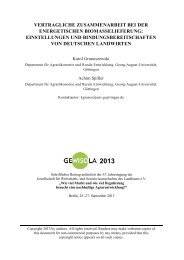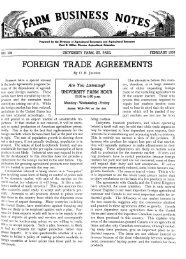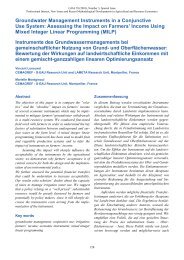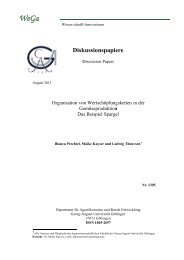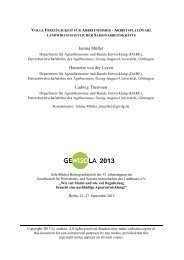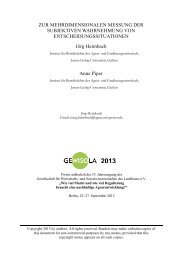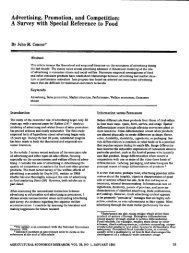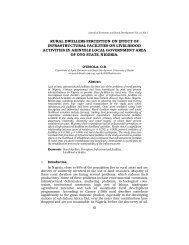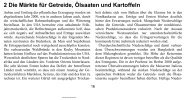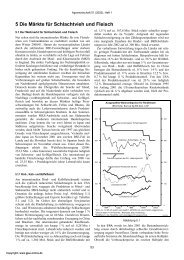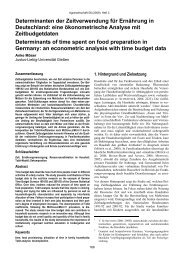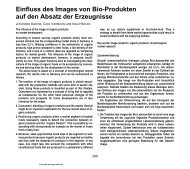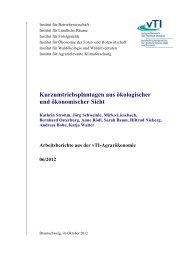Impact of Foreign Intellectual Property Rights ... - AgEcon Search
Impact of Foreign Intellectual Property Rights ... - AgEcon Search
Impact of Foreign Intellectual Property Rights ... - AgEcon Search
Create successful ePaper yourself
Turn your PDF publications into a flip-book with our unique Google optimized e-Paper software.
<strong>Impact</strong> <strong>of</strong> <strong>Foreign</strong> <strong>Intellectual</strong> <strong>Property</strong> <strong>Rights</strong> Protection<br />
on U.S. Exports and FDI<br />
Weishi GU<br />
Graduate Student, Department <strong>of</strong> Applied Economics and Management, Cornell University,<br />
NY 14850, USA. Email: wg62@cornell.edu<br />
Selected Paper prepared for presentation at the American Agricultural Economics Association<br />
Annual Meeting, Milwaukee, WI, July, 2009<br />
______________________________<br />
*Copyright 2009 Weishi Gu. All rights reserved.<br />
Please DO NOT cite this version <strong>of</strong> the paper without prior permission from the authors.<br />
1
ABSTRACT<br />
Since the early 1990s, there has been a growing interest in the potential contribution <strong>of</strong><br />
intellectual property rights (IPR) protection to global trade and investment. However, there<br />
is an ongoing debate among analysts regarding the extent to which stronger IPR actually<br />
stimulate international transactions via transfer <strong>of</strong> technology. This paper addresses this<br />
issue by evaluating how foreign intellectual property rights (IPR) protection affects how<br />
U.S. firms serve overseas markets through exports and foreign direct investment (FDI).<br />
Using panel data from 53 countries over 1994-2006, the empirical analysis was based on a<br />
dynamic system GMM modeling framework. The empirical results suggest that IPR has a<br />
weak negative effect on U.S. exports, but a statistically significant positive effect on U.S.<br />
FDI. In addition, the results also indicated that less US exports flow to countries with<br />
weak imitative ability after they strengthen IPR protection.<br />
Key Words: export, FDI, technology transfer, intellectual property rights, GMM.<br />
JEL Classification Numbers: C33, F21, F23, F14, O34, K33.<br />
2
1. Introduction<br />
The passage <strong>of</strong> the World Trade Organization’s (WTO) Agreement on Trade-<br />
Related Aspects <strong>of</strong> <strong>Intellectual</strong> <strong>Property</strong> <strong>Rights</strong> Agreement (TRIPS) in 1995 is a major<br />
milestone in global efforts to harmonize international laws governing intellectual property<br />
rights. Since the inception <strong>of</strong> the TRIPS agreement, the potential impact <strong>of</strong> stronger<br />
intellectual property rights (IPR) on international trade and global investment has been a<br />
subject <strong>of</strong> great interest among researchers and policymakers. While no consensus has<br />
emerged among experts, the strengthening <strong>of</strong> IPR laws has the potential to benefit<br />
producers and consumers in both industrialized and developing countries via the<br />
encouragement <strong>of</strong> innovative activities and easier flow <strong>of</strong> technology and knowledge-based<br />
factors <strong>of</strong> production.<br />
There are three major ways through which companies can serve foreign<br />
markets and transfer technologies across international borders: exports, foreign direct<br />
investment (FDI), and licensing (Maskus, 2004; Smith, 2001). According to government<br />
statistics, U.S. exports was $623 billion in 1996, U.S. FDI was $795 billion, and U.S.<br />
received royalties and license fees (including those from both affiliates and the unaffiliated)<br />
was only $32 billion at the same period. In contrast by 2006, this values these numbers<br />
have increased significantly for exports ($1,037 billion), FDI ($2,384 billion) and received<br />
royalties and license fees ($62 billion), respectively (U.S. Bureau <strong>of</strong> Economic Analysis<br />
(BEA). Among the three types <strong>of</strong> international transactions, licenses account for the least<br />
amount and the data for license fees are not as readily available for it. Thus, this paper<br />
focuses on the impact <strong>of</strong> IPR protection on exports and FDI only.<br />
There is an ongoing debate among analysts regarding the extent to which<br />
stronger IPR actually stimulate international transactions via transfer <strong>of</strong> technology (Park<br />
and Lippoldt, 2003). Despite a growing literature on the issue, the question remains as to<br />
whether the strengthening <strong>of</strong> IPR protection is an effective way to promote technological<br />
3
transfers to developing countries? Two opposing views exist on the issue. First, critics<br />
argue that stronger IPR increases the market power <strong>of</strong> technology holders and leads to<br />
higher prices, with the possible consequence that some developing countries may have<br />
even less access to new technologies. In addition, stronger IPR could also impose higher<br />
cost barriers to local firms in developing countries that may want to develop their products<br />
imitation <strong>of</strong> knowledge-based technologies embedded in foreign imports.<br />
In contrast, proponents <strong>of</strong> stronger IPR protection contend that infringements<br />
<strong>of</strong> IPR laws have only short-term benefits. In the long run, a regime that permits free<br />
technology copying and piracy <strong>of</strong> intellectual property will discourage innovation. The<br />
lack <strong>of</strong> consensus on the impacts <strong>of</strong> stronger IPR protection on trade and investment points<br />
to a need for more empirical investigations <strong>of</strong> this important issue. Unfortunately,<br />
empirical evidence on impacts <strong>of</strong> IPR protection is relatively scarce (Ferrantino, 1993;<br />
Maskus, 1998a; Smith, 2001; Park and Lippoldt, 2003).<br />
This paper addresses this issue by evaluating how foreign intellectual property<br />
rights (IPR) protection affects how U.S. firms serve overseas markets through exports and<br />
foreign direct investment (FDI). Based on Smith (2001), this paper extends the literature<br />
in three ways. First, in contrast to most previous studies that study the effects <strong>of</strong> IPR on<br />
exports and FDI separately, we analyze the relationships jointly. Second, this paper goes<br />
beyond the common cross-sectional analysis based on one year <strong>of</strong> data for multiple<br />
countries (Maskus and Penubarti, 1998; Smith, 2001). Rather we adopt a panel data<br />
estimator that allows for capturing the dynamics in the relationships among the variables in<br />
the system. For example, the panel data (1994-2006) used in this study could potential<br />
capture the variations in the data due to evolution <strong>of</strong> foreign IPR regimes since mid-1990s.<br />
Third, instead <strong>of</strong> using basic OLS regression models (and its variants), this paper better<br />
addresses potential endogeneity issues by adopting dynamic system panel GMM estimator.<br />
4
The rest <strong>of</strong> the paper is organized as follows. Section 2 contains a brief review<br />
<strong>of</strong> the literature while section 3 presents an outline <strong>of</strong> the conceptual framework on the<br />
relationship between IPR protection and multinational firm’s international transactions and<br />
the hypotheses tested in the empirical analyses. Section 4 describes the empirical<br />
methodology and data and section 5 contains a discussion <strong>of</strong> the results. The last section<br />
provides concluding remarks.<br />
2. Conceptual Framework<br />
In Dunning’s (1993) famous OLI paradigm, production and marketing<br />
decisions by multinational enterprises are driven by three factors: ownership (O), location<br />
(L), and internalization (I) advantages. Ownership (or firm-specific) advantages over<br />
certain technology and knowledge-based assets (e.g., patented technology, trademarks,<br />
marketing processes, etc.) are necessary for a MNE to be able to effectively compete with<br />
local firms in a foreign country. Ownership advantages must be strong enough to<br />
compensate for the additional cost <strong>of</strong> operating abroad.. Ownership advantages must also<br />
allow for the firm to have exclusive rights and control over intellectual property that would<br />
prevent its knowledge-based assets from being pirated or imitated by other.firms in the<br />
foreign country. Thus, stronger IPR protection can better protect multinational firms’<br />
ownership rights over their knowledge assets. Hence, stronger IPR could encourage<br />
international transactions through the channels <strong>of</strong> exports and FDI.<br />
In contrast, location (country-specific) advantages are the basis for the MNEs<br />
decision to either export or engage in local production in the host country. MNEs decision<br />
to locate production overseas is <strong>of</strong>ten driven by the firm’s desire to take advantage factor<br />
advantages (e.g., lower labor cost, extractive natural resource, market size) in the host<br />
country. There are <strong>of</strong>ten imperfect markets for key intermediate products and factors (e.g.,<br />
human capital, knowledge and managerial skills), MNE uses their internalization (or<br />
5
control) advantages to control and internalize transaction costs. MNEs may be reluctant to<br />
license their technology to foreign producers in countries with weak IPR laws where the<br />
likelihood <strong>of</strong> illegal imitation is high.<br />
Nevertheless, the existing theoretical literature provide no definitive guidance<br />
on whether enhanced ownership advantage via stronger IPR protection increases or<br />
decreases international trade and investment. It is plausible to expect that the strengthening<br />
<strong>of</strong> IPR protection would have a positive “market expansion effect” such that multinational<br />
firms can increase their market shares in the host country. In contrast, it is equally likely<br />
that stronger IPR protection would result in a “market power effect” that would induce the<br />
firm to restrain its output sales in foreign markets in order to enjoy monopoly advantages<br />
and higher prices (Maskus and Penubarti, 1995; Smith, 2001). Therefore, the net<br />
theoretical effect <strong>of</strong> IPR on international trade and investment through ownership<br />
advantage is indeterminate. This is an empirical question in need <strong>of</strong> further investigation.<br />
Thus, the following testable hypotheses are postulated.<br />
Hypothesis 1. Stronger IPR-promoted ownership advantage increases U.S. exports and<br />
FDI according to market expansion effect and decreases them due to market power effect.<br />
The impact <strong>of</strong> stronger IPR protections may vary between exports and FDI.<br />
Stronger IPR protection can increase the cost <strong>of</strong> imitation, and thus decrease the<br />
probability <strong>of</strong> piracy and other violations <strong>of</strong> knowledge-based assets. Therefore, for<br />
different host countries with their certain levels <strong>of</strong> IPR regime, U.S. firms have to balance<br />
their possible costs <strong>of</strong> disadvantages in operating abroad including knowledge imitation<br />
and their benefits from location advantages, then make decisions on whether and how to<br />
access to and expand in overseas markets. This means that IPR should have different<br />
6
influences on U.S. firms’ exports and FDI. To be more specific, strong IPR should confer a<br />
location advantage inducing more FDI, while weak IPR should <strong>of</strong>fset the advantage and<br />
make firms lean to exports (Smith, 2001). It also indicates that IPR protection is more<br />
important to FDI than to exports, given FDI is easier to have knowledge assets violated.<br />
Therefore, during this international trade and investment decision process, relative effects<br />
<strong>of</strong> IPR on exports and FDI are expected to be different.<br />
Hypothesis 2. Strong IPR confers a location advantage which increases more U.S. FDI<br />
relative to exports.<br />
The above hypothesis on IPR and international transaction relationship,<br />
however, is conditional and affected by other specific factors. These factors include, but<br />
are not limited to, foreign countries’ imitative ability (Smith, 2001) and knowledge assets<br />
sophistication (Nicholson, 2002). Regarding IPR enhanced ownership’s market power<br />
effect, Smith (2001) proposes that when IPR has been strengthened, countries with strong<br />
imitative ability usually will not be easily controlled by this IPR enhanced ownership’s<br />
market power effect, while countries with weak imitative ability <strong>of</strong>ten have to experience<br />
at least temporary monopolies. Therefore, countries with weak imitative abilities may<br />
experience a decrease in international trade and investment while their IPR regime<br />
strengthened. Strong IPR may enable foreign trade and investment become smoother in<br />
strong imitative ability countries with well-educated workers. Therefore, stronger IPR<br />
should have little positive or even negative effect on international transaction to countries<br />
with weak imitative abilities but large positive effect to countries with strong imitative<br />
abilities (Smith, 2001).<br />
7
Here this paper examines these proposals about foreign countries’ strong/weak<br />
imitative abilities again with more updated data and comprehensive models. We suggest<br />
that given strengthened IPR, weak imitative countries are more easily dominated by market<br />
power’s negative effect on international trade and investment while strong imitative<br />
countries are more affected by market expansion’s positive effect, without considering<br />
effects from location advantage. Then with regards to the effects from location advantage,<br />
this paper proposes the following hypothesis:<br />
Hypothesis 3. Strong IPR makes countries with weak imitative ability more easily<br />
dominated by market power’s negative effect on exports and FDI. But for FDI, this<br />
negative effect may be <strong>of</strong>fset by IPR enhanced location advantage.<br />
Hypothesis 4. Strong IPR enables countries with strong imitative ability to be more<br />
affected by market expansion’s positive effect on exports and FDI. For FDI, this positive<br />
effect can be further strengthened by IPR enhanced location advantage.<br />
Helpman (1993) developed a two-region (North-South) general equilibrium<br />
model for FDI and showed that the ultimate effect <strong>of</strong> IPR reforms on the global economy<br />
hinges on the manner and the extent <strong>of</strong> the MNE’s response to the reforms. Later studies<br />
by Lai (1998) concludes that stronger IPR in the South leads to an acceleration <strong>of</strong><br />
production-shifting from North to South and to higher rates <strong>of</strong> innovation in the North.<br />
Branstetter, Fisman, Foley, and Saggi (2007), in their North-South product cycle model,<br />
predict that IPR reform in the South leads to increased FDI too. By analyzing responses <strong>of</strong><br />
U.S.-based MNE to the foreign IPR reforms in the 1980s and 1990s, they further<br />
empirically found that MNE indeed expanded the scale <strong>of</strong> their activities in IPR reforming<br />
8
countries. However, Glass and Saggi’s (2002) model demonstrates the opposite, that by<br />
making imitation more costly, stronger Southern IPR protection forces the South to spend<br />
more resources on imitation and causes resources scarcity which reduces FDI from the<br />
North.<br />
So far we have focused on a narrow interpretation <strong>of</strong> how IPR protection<br />
affects FDI in terms <strong>of</strong> technology transfer. Many scholars, however, claim that stronger<br />
IPR is <strong>of</strong> broader importance in signaling to potential investors how a host country<br />
recognizes and protects the rights <strong>of</strong> MNE (Maskus, 1998b; Sherwood, 1990). In this view,<br />
trade liberalization, or market restriction removal, is insufficient to provide assurances that<br />
an economy becomes more open to MNE. Stronger IPR regimes convey a commitment<br />
from governments in emerging economies to shift toward a more business-friendly<br />
environment. Overall, most time people expect stronger IPR would encourage FDI.<br />
3. Empirical Literature Review<br />
3.1 IPR with Export and FDI together<br />
As noted earlier, few country-level empirical studies examined export and FDI<br />
together. Such research include Ferrantino (1993), Maskus (1998a), Fink (2000), Smith<br />
(2001), Lesser (2002), and Park and Lippoldt (2003). Ferrantino (1993) uses 1982 cross-<br />
country data to investigate the effects <strong>of</strong> membership in the intellectual property treaties in<br />
the context <strong>of</strong> U.S. exports and foreign affiliate sales. The membership stimulates flows <strong>of</strong><br />
U.S. receipts <strong>of</strong> unaffiliated royalties and license fees from the host country with a<br />
sufficiently strong IPR regime. Moreover, he also finds that exports from U.S. firms to<br />
their overseas affiliates are significantly higher in countries without IPR membership than<br />
with the membership, indicating that stronger IPR protection may switch away exports to<br />
9
subsidiaries and replace it with other exchange modes. Nevertheless, Ferrantino (1993)<br />
also shows that the IPR treaties membership has minimal impact on U.S. exports to<br />
unaffiliated firms and FDI.<br />
Maskus (1998a) estimates a simultaneous set <strong>of</strong> equations by seemingly<br />
unrelated regressions (SUR) to capture the joint impacts <strong>of</strong> IPR on exports, FDI and<br />
licensing, controlling for market size, tariff protection, the level <strong>of</strong> local R&D by affiliates,<br />
distance from the United States, and investment incentives and disincentives provided by<br />
local authorities. This is done for a panel <strong>of</strong> 46 destination countries, using annual data<br />
from 1989-1992. His index <strong>of</strong> patent strength is taken from Maskus and Penubarti (1995).<br />
He finds positive effect <strong>of</strong> IPR on U.S. exports to affiliates in developing countries and<br />
insignificant effect <strong>of</strong> IPR on U.S. affiliates’ sales.<br />
Fink (2000) studies the relationship between IPR and FDI and trade for both<br />
the U.S. and Germany. However, he finds no important role for IPR in influencing total<br />
international transactions for the U.S. at country level.<br />
Using cross-sectional data in 1989 for a sample <strong>of</strong> 50 countries, Smith (2001)<br />
studies the impact <strong>of</strong> patent index on U.S. exports, FDI, and licenses. By applying<br />
seemingly unrelated regressions (SUR), she shows that strong patent protection increases<br />
U.S. affiliate sales, particularly across countries with strong imitative abilities. However,<br />
she finds weak statistical evidence that IPR affects exports.<br />
Lesser (2002) develops a new index <strong>of</strong> IPR protection for 44 developing<br />
countries in 1998. Using this index and a set <strong>of</strong> cross-country data for the year 1998, he<br />
performed a linear model using a non-normalized dependent variable. He concludes that<br />
the relationships between the IPR score and FDI and between IPR and foreign countries’<br />
imports are both positive and significant. A one point increase in the score, meaning<br />
stronger IPR protection, would on average increase FDI by $1.5 billion.<br />
10
Park and Lippoldt (2003) investigate the IPR relationship with FDI and trade<br />
using data at both national and industry levels from 1990 to 2000. They find that the patent<br />
rights as described by index are associated positively with FDI and moderately with trade.<br />
Their results indicate that variation in FDI in relation to strengthened patent rights is<br />
largest for the least developed nations where IPR regimes are weakest, and second largest<br />
for the developing nations where IPR regimes are next weakest. Thus, patent rights appear<br />
to have a positive but diminishing association with increased FDI as the strength <strong>of</strong> those<br />
rights increases. Yet, the results do not imply that stronger patent protection will always<br />
raise FDI and trade. There may come a point where these types <strong>of</strong> IPR are too strong – in<br />
the sense that they grant producers <strong>of</strong> intellectual products excessive market power – in<br />
which case IPR may negatively influence FDI and trade. Thus, their empirical finding is<br />
that the positive effect <strong>of</strong> strong IPR is only conditional on systems that do not reach an<br />
excessive level <strong>of</strong> strength. Although papers above have well addressed IPR’s effects on<br />
both exports and FDI, little has been done about endogeneity problem in their models. This<br />
paper will tackle the issue through using GMM estimators.<br />
3.2 IPR with only Export<br />
Apart from more comprehensive analyses above, several empirical studies can<br />
be found on the relationship <strong>of</strong> IPR and trade flows exclusively (Fink and Primo Braga,<br />
2005; Maskus, 2000; Maskus and Penubarti, 1995; Primo Braga and Fink, 1997; Smith,<br />
1999), but the results are ambiguous. Maskus and Penubarti (1995) are the first to relate<br />
international trade flows to the cross-country strength <strong>of</strong> patent laws. They applied two-<br />
stage least squares method to a data set <strong>of</strong> bilateral imports from OECD countries to<br />
themselves and to a large group <strong>of</strong> developing countries in detailed manufacturing<br />
categories. Their conclusion is that import volumes were positively and significantly<br />
affected by increases in Rapp and Rozek’s (1990) patent index across most manufacturing<br />
11
categories, particularly in large and middle-income countries. Primo Braga and Fink (1997)<br />
estimate a similar model and found the same positive links between patent protection and<br />
trade flows. Later their another work in 2005 further confirms the the significantly positive<br />
effect <strong>of</strong> higher levels <strong>of</strong> IPR protection on nonfuel trade. However, their result also show<br />
that when confining the estmiation to high-technology goods, there is no such significant<br />
effect found.<br />
Smith (1999) refines Maskus and Penubarti (1995) by distinguishing between<br />
types <strong>of</strong> importers, i.e. countries presenting an imitative threat and countries not. She uses<br />
data on state-to-country manufacturing exports in 1992 and performs regressions with<br />
fixed effects. Her IPR indices from both Rapp and Rozek (1990) and Ginarte and Park<br />
(1997). Smith (1999) results show that U.S. firms would indeed expand their exports to<br />
strong imitative nations significantly if they have stronger IPR regimes. She also finds that<br />
the poorest countries with no imitative threat might not experience rising international<br />
technology transfer through imports even upon adopting TRIPS-consistent IPR regimes.<br />
Strengthening patent rights in those countries reinforces monopoly power and reduces U.S.<br />
exports to them.<br />
3.3 IPR with only FDI<br />
Also many empirical studies have been done regarding the relationship<br />
between IPR protection and just FDI (Branstetter, Fisman, Foley, and Saggi, 2007;<br />
Javorcik, 2004; Kumar, 2000; Lee and Mansfield, 1996; Mansfield, 1994; Nicholson, 2007;<br />
Nunnenkamp and Spatz, 2004; Seyoum, 1996). Among them, Branstetter, Fisman, Foley,<br />
and Saggi (2007) analyzes responses <strong>of</strong> U.S. MNE to well-documented discrete changes in<br />
patent regimes over the 1980s and 1990s in sixteen countries at firm level. They apply time<br />
and affiliates/industry fixed effects and find that MNE expand the scale <strong>of</strong> their activities<br />
in reforming countries after IPR reform. Javorcik (2004), using a unique firm-level data set<br />
12
from Eastern Europe and the former Soviet Union, adopted probit model to study MNE<br />
FDI decisions. He finds that weak IPR protection deters FDI in technology-intensive<br />
sectors that rely heavily on IPR for the security <strong>of</strong> knowledge assets. He also indicates that<br />
weak IPR regime encourages MNE to undertake FDI projects focusing on distribution<br />
rather than local production.<br />
Lee and Mansfield (1996) using least squares estimation find a positive<br />
relationship between IPR and FDI, based on data obtained from a survey <strong>of</strong> almost 100<br />
U.S. MNE regarding their perceptions <strong>of</strong> IPR protection in various host countries.<br />
Mansfield (1994) has similar findings, particularly in high-technology industries. He also<br />
indicates, as Javorcik (2004) does, that IPR seems to influence the composition and extent<br />
<strong>of</strong> U.S. FDI although the size <strong>of</strong> the effects seems to differ from industry to industry.<br />
Nunnenkamp and Spatz (2004) adopts two-stage least squares method to disaggregated<br />
data for seven industries in 1995 and five industries in 2000. They conclude that the<br />
relationship between FDI and IPR depends on characteristics <strong>of</strong> both industry and host-<br />
country by using sectorally disaggregated FDI data for a large sample <strong>of</strong> host countries.<br />
Similarly, Seyoum’s (1996) results <strong>of</strong> IPR’s influence on FDI are varied from<br />
different host countries. Moreover, he distinguishes different types <strong>of</strong> intellectual property<br />
rights into patents, copyright, trade secrets, and trademark. He finds that copyright’s<br />
protection has constant positive effects on FDI across different types <strong>of</strong> countries, while<br />
the other IPR’s effects can be positive or negative according to how developed a country is.<br />
Seyoum also concludes that, for the less developed, IPR factors can explain 13 percent <strong>of</strong><br />
the variation in FDI flows, while in the emerging economies IPR capture 43 percent <strong>of</strong> FDI<br />
variation and is a much more important factor than other economic policy variables.<br />
However, in his intellectual property rights model, Seyoum (1996) does not include any<br />
13
economic policy variables, which may induce estimation bias and arouse questions to the<br />
results.<br />
Though most studies above find significantly positive relationship between<br />
IPR and FDI, there are a few others concluding no such connection. For instance, Kumar<br />
(2000) studies affiliates <strong>of</strong> US and Japanese MNEs in seven broad sectors <strong>of</strong><br />
manufacturing in 74 host countries at three points <strong>of</strong> time over the 1982-1994 period.<br />
Applied fixed effects, he shows that the strength <strong>of</strong> patent protection regime although with<br />
a positive sign never has a statistically significant coefficient for affiliate sales in his case<br />
for U.S. MNE. In his case for Japanese MNE, patent rights protection is only significant<br />
upon inclusion <strong>of</strong> dummy variables distinguishing Asian host countries.<br />
3.4 Other Factors Affecting Export and FDI<br />
Apart from the potential effect <strong>of</strong> IPR, a second influential element is distance<br />
between the transaction parties that has especially been emphasized by gravity model. The<br />
model presents an empirical analysis for international trade. It suggests that trade is based<br />
on the distance between countries and the interaction <strong>of</strong> the countries’ economic sizes,<br />
mimicking the Newtonian law <strong>of</strong> gravity which considers distance and physical size<br />
between two objects. Gravity model has been proven to be strong through both theoretical<br />
foundations (Anderson, 1979; Anderson and Wincoop, 2003; and Bergstrand, 1990) and<br />
many empirical econometric analyses. Later, other factors, such as income level and<br />
populations, are also included in expanded versions <strong>of</strong> the model, depending on different<br />
cases. This paper uses GDP for countries’ economic sizes in addition to variable distance.<br />
GDP, in addition to its function in the gravity model, is also good<br />
measurement for host countries’ market sizes. Many empirical works have shown<br />
significant effects <strong>of</strong> market size on international trade and investment. For example,<br />
Bandera and White (1968) find a statistically significant relationship between U.S. FDI in<br />
14
European countries and their national incomes (GNP). They concluded that motives for<br />
FDI can be adequately summarized as a desire to penetrate the growing market defined in<br />
terms <strong>of</strong> level and growth <strong>of</strong> GNP <strong>of</strong> host countries. Similar results are found by<br />
Scaperlanda and Mauer (1969) and many other studies afterwards (Fink, 2000; Lesser,<br />
2002; Maskus, 1998). Thereafter, market size has become a well-recognized variable to be<br />
used in later studies which would be too many to cite. Moreover, from the perspective <strong>of</strong><br />
FDI types, this market size effect is likely to be valid for the FDI undertaken to produce<br />
final goods, i.e. horizontal FDI; but it has less power to explain vertical FDI meant to<br />
produce intermediate goods for exports afterwards.<br />
<strong>Foreign</strong> country’s openness to trade and investment is another factor related<br />
with international involvement and has been widely used (Branstetter, Fisman, Foley, and<br />
Saggi, 2007; Lesser, 2002; Smith, 2001). Most economists agree that higher openness<br />
should enable more international transactions. Lee and Mansfield (1996) found openness<br />
has a significantly positive effect on U.S. FDI. Wheeler and Mody (1992), however,<br />
suggested the opposite effect and claimed that when FDI production is for the local market,<br />
openness <strong>of</strong> the economy actually reduces investment. This outcome might result from<br />
different type <strong>of</strong> openness or more intensive competition brought by the openness. And at<br />
the same time, some other studies suggest mixed effect <strong>of</strong> openness on international trade<br />
and investment (Smarzynska, 2004 and Smith, 2001). These ambiguous results may be<br />
also due to the variation in openness measurements used by different studies.<br />
The incentives to international involvement, especially income tax exemption,<br />
would be a third factor worth special attention. According to De Mooij and Ederveen’s<br />
(2003) detailed discussion <strong>of</strong> taxes effects on FDI literature across 25 studies, a median<br />
tax-elasticity <strong>of</strong> FDI is -3.3, which implies that higher taxes do affect FDI inflows<br />
negatively. There, however, are others who argue that those incentives from governments<br />
15
do not really help attract international trade and investment. The main reason is that<br />
usually disincentives will also be attached to the incentives or that incentives have too<br />
many restrictions to apply. More comprehensive discussion can be found in Agarwal<br />
(1980). Empirically, Smith (2001) finds significant effect <strong>of</strong> taxes on FDI, and so do<br />
Smarzynska (2004) and Branstetter, Fisman, Foley, and Saggi (2007) though their results<br />
are mixed.<br />
Last, there are many other factors affecting international trade and investment,<br />
for instance, exchange rate and its volatility, labor cost, political stabililty, managerial<br />
unrational behavior, institution quality, oligopolistic reaction, past international experience,<br />
diplomatic relationships between countries. This paper here only uses exchange rate and<br />
past international experience as additional variables. The others are not included in this<br />
analysis, so that these complicated variables that usually mingle empirical results or are<br />
difficult to measure would not prevent us too much from studying our key variable IPR.<br />
And this paper does include control variables commonly used in most previous relevant<br />
studies.<br />
4. Empirical Methodology and Data<br />
4.1 Econometric Model Specification<br />
This paper uses gravity model for panel data as the basis for empirical model<br />
specification. Gravity model provides a generalized framework consistent with a variety <strong>of</strong><br />
general equilibrium international trade models. In addition, the theoretical and empirical<br />
foundation for this modeling approach is well outlined in past research (Anderson, 1979;<br />
Anderson and Wincoop, 2003; Brainard, 1993; Bergstrand, 1990; Ferrantino, 1993; Fink<br />
and Primo Braga, 2005; Horstmann and Markusen, 1987 and 1992; Nicholson, 2007; and<br />
Smith, 2001). Therefore, the model specification here is:<br />
16
ln( Y ) �� �� �PAT �� �ln( GDP ) �� �ln( DIST ) ���X � � (1)<br />
k 0 1 k 2 k 3<br />
k k k<br />
where Yk is international trade and investment outflow from U.S. to host country k, here in<br />
this paper Y takes the forms <strong>of</strong> exports (EXP) and FDI. GDPk stands for gross domestic<br />
production or income <strong>of</strong> host country k. DISTk is for distance between country k and U.S.,<br />
and PAT for measure <strong>of</strong> IPR protection strength. Furthermore, Xk includes all the other<br />
explanatory variables, i.e. lagged Y term (LY), exchange rate (EXR), openness to<br />
international economic involvement (OPEN), imitative ability (IMI), and FDI for export<br />
equation, foreign corporate tax rates (TAX) and export (EXP) for FDI equation. Last, εk is<br />
a normally distributed error term.<br />
This paper also estimates a modified version <strong>of</strong> Equation (1) that interacts<br />
dummy variables <strong>of</strong> strong and weak imitative abilities with the IPR variable. This<br />
modified version would allow us to examine Hypothesis 3 and 4 in earlier section. The<br />
specification is:<br />
ln( Yk) ��0 ��0si�DUMSIk ��1wi�PATWIk ��1si�PATSIk �� �ln( GDP ) �� �ln( DIST ) ���X�� (2)<br />
2 k 3<br />
k k k<br />
where DUMSIk is a 0/1 dummy variable for strong imitative ability <strong>of</strong> host countries,<br />
DUMSIk equals one for countries with strong imitative abilities and otherwise 0. There is<br />
also a counterpart variable DUMWIk. It is also a 0/1 dummy variable for weak imitative<br />
ability <strong>of</strong> host countries, DUMWIk equals one for countries with weak imitative abilities<br />
and otherwise 0. PATWIk is the product <strong>of</strong> variable PAT and DUMWIk and PATSIk is the<br />
product <strong>of</strong> variable PATk and DUMSIk. This diagonal dummy variable structure and<br />
interaction terms enable us to directly observe IPR’s effects on Y to countries with strong<br />
imitative abilities and on Y to countries with weak imitative abilities respectively. This<br />
dummy specification also aligns with Smith (2001), who used the same setup. Equation (2)<br />
17
also includes an intercept-shift term, DUMSIk, that controls for strong imitative abilities’<br />
effect by itself and unmeasured determinants <strong>of</strong> international transaction related to the<br />
imitative abilities <strong>of</strong> countries 1 .<br />
Now we interpret the parameters based on predictions from the conceptual<br />
framework and literature review earlier. Table 1 summaries the expected parameter signs<br />
for each form <strong>of</strong> the international transactions. First, this paper expects positive<br />
coefficients for foreign GDP and negatives for geographical distance in the equations for<br />
exports and FDI. Second, we expect ambiguous signs for IPR coefficients in exports and<br />
FDI equations. This is because that when market expansion dominates market power we<br />
will have a positive coefficient but otherwise it will be negative or zero due to <strong>of</strong>fsets from<br />
market power effect. Yet, market expansion effect on FDI will be reinforced by IPR<br />
enhanced location advantage. Third, strong imitative ability by itself should impose threats<br />
to knowledge assets and have a negative effect on international trade and investment. But it<br />
may also smooth international production with better educated labor for FDI. Fourth, for<br />
interactions between IPR’s influence and country’s imitative ability, according to previous<br />
section we suggest that given strengthened IPR, weak imitative countries are more easily<br />
dominated by market power’s negative effect on international trade and investment while<br />
strong imitative countries are more affected by market expansion’s positive effect. But as<br />
said before, the possible negative sign <strong>of</strong> IPR <strong>of</strong> weak imitative ability countries for FDI<br />
and licenses may also be <strong>of</strong>fset by IPR enhanced location advantage. Moreover, this paper<br />
expects exports to decline and FDI to rise as USD strengthened. Also a positive sign <strong>of</strong><br />
OPEN’s parameter is predicted for both international transaction modes. Finally, we<br />
propose negative parameters on TAX in the equation for FDI.<br />
1 The specification in the equation (1) and (2) are based on conceptual framework, Smith (2001), many trials,<br />
and other relevant papers.<br />
18
4.2 Method<br />
Hypothesis tests for multicollinearity, endogeneity, autocorrelation,<br />
heteroscadasticity, and fixed/random effects have been performed by Stata. They are VIF<br />
for multicollinearity, Wooldridge’s test for autocorrelation, likelihood ratio test for<br />
heteroscadasticity, and Hausman test for fixed/random effects. This paper found no<br />
multicollinearity. Endogeneity problem with GDP has been detected for sure. First order<br />
autocorrelation and cross-sectional heteroscadasticity 2 do exist and have been addressed<br />
with the use <strong>of</strong> robust standard errors. Fixed effects estimates are preferred to the random.<br />
The sample years covered by this paper are 1994-2006. A list <strong>of</strong> 53 countries under study<br />
can be found in Appendix 1.<br />
In order to better account for endogeneity problem under this circumstance,<br />
this paper adopts dynamic GMM. GMM is a well regarded method when an equation has<br />
the presence <strong>of</strong> lagged dependent variable, non-strictly exogenous independent variables,<br />
fixed effects, heteroscadasticity and first order autocorrelation problems. It especially fits<br />
for panels with short time period but large individual number and is found more efficient<br />
than 2SLS under heteroscadasticity and autocorrelation. One thing, however, is that GMM<br />
does require no second order autocorrelation existing. Here, after each GMM estimation,<br />
Arellano-Bond test for AR(2) in first differences has been performed. Sargan test <strong>of</strong><br />
overidentification restriction have also been done. Additionally, this paper restricts sets the<br />
maximum number <strong>of</strong> lags <strong>of</strong> the predetermined variables that can be used as instruments to<br />
prevent too many instruments from being applied. The dangers associated with having<br />
many instruments relative to observations are documented in the applied literature. The<br />
instruments can overfit endogenous variables, failing to expunge their endogenous<br />
2 For exports equation, the test does not reject heterscadasticity at 10% but reject at 15% significant level.<br />
Given our sample with more than 50 countries, heteroscadasticity should be considered for sure.<br />
19
components and biasing coefficient estimates. Meanwhile, they can also vitiate statistical<br />
tests.<br />
Between differenced GMM (Arellano and Bond, 1991 and 1998) and system<br />
GMM (Arellano, 1995; Blundell and Bond, 1998), usually system GMM will be preferred<br />
because <strong>of</strong> its higher efficiency than differenced GMM by empirical literature and<br />
simulation studies (Hayakawa, 2007). Differenced GMM could be consistent, but also<br />
suffer from finite sample bias and estimated coefficients have down-ward biased problem.<br />
System GMM uses an additional set <strong>of</strong> moment conditions where the differenced are used<br />
as instruments for the level equations, which can better solve such problems. Therefore,<br />
this paper uses system GMM estimates.<br />
Furthermore, between one-step GMM and two-step GMM, Arellano and Bond<br />
(1991) recommended using one step GMM results for coefficient inference because the<br />
two step standard errors tend to be biased downward in small samples. Two step GMM<br />
post-estimation hypothesis test, however, may be better for performing inference on model<br />
specification. Two-step GMM’s Sargan overidentification tests usually will be more<br />
efficient and preferred than the one step Sargan test with the presence <strong>of</strong> heteroscadasticity.<br />
This paper will report both one-step and two-step results from dynamic system GMM.<br />
4.3 Data<br />
4.3.1 IPR Measurements<br />
Several indices have emerged for the measurement <strong>of</strong> IPR protection with<br />
increasing academic and policy-oriented interest in IPR. The first such index was<br />
developed by Rapp and Rozek in 1990. They rated the patent laws <strong>of</strong> 157 countries on a<br />
scale from 0 to 5. As a measure for the strength <strong>of</strong> IPR protection, however, the index is<br />
incomplete because it ignores other types <strong>of</strong> IPR other than patent, such as trademark and<br />
20
copyright. It also does not take into consideration the enforcement <strong>of</strong> a country’s patent<br />
laws.<br />
Subsequently, Ginarte and Park (1997) constructed a more elaborate ranking<br />
that significantly expanded the work by Rapp and Rozek (1990). Their index has become<br />
one <strong>of</strong> the most widely used indices in evaluating patent laws on the books. Later, Ginarte<br />
and Park’s patent index has been extended to more recent years in Park (2008). This paper<br />
will apply this index as measure <strong>of</strong> IPR protection to be comparable with other relevant<br />
studies.<br />
To consider all types <strong>of</strong> IPR and address how the law on paper has performed<br />
in practice, Lee and Mansfield (1996) compiled another index <strong>of</strong> IPR protection for 16<br />
developing countries and newly industrialized countries by calculating shares <strong>of</strong> U.S. firms<br />
who reported that their host country IPR regimes were too weak to allow investment,<br />
technology transfer, or licensing. Similarly, Seyoum (1996) measures IPR protection in a<br />
scale <strong>of</strong> 0-3 through a survey sent to IPR practitioners. Sherwood (1997) proposes a third<br />
measure <strong>of</strong> IPR protection that combined personal knowledge and experience with<br />
pr<strong>of</strong>essional interviews, which however is regarded as subjective by some researchers<br />
(Primo Braga and Fink, 1998).<br />
Other sources <strong>of</strong> comprehensive IPR indices include Lesser (2002), Horst<br />
(2006), the World Economic Forum’s (WEF) Global Competitiveness Reports, and the<br />
Economic Freedom <strong>of</strong> the World Annual Report (EFW, 1980-2006). They are all based on<br />
both laws on the books and enforcement. This paper uses both EFW’s IPR index and Park<br />
(2008) patent index as measure for the protection, and compares results.<br />
21
4.3.2 Other Data Sources<br />
Data for U.S. exports in FAS Value 3 are from the U.S. Department <strong>of</strong><br />
Commerce and the U.S. International Trade Commission websites. U.S. FDI and licenses<br />
data were obtained from the Bureau <strong>of</strong> Economic Analysis’ (BEA) online databank. FDI<br />
can be measured as affiliates’ sales, value added, and FDI position on a historical-cost<br />
basis in U.S. dollar value, and this paper selects the third measurement.<br />
Independent variables regarding host countries apart from IPR will be GDP,<br />
geographical distance, exchange rate, U.S. foreign affiliate received tax rate, and openness<br />
to international transactions. Host country’s GDP at current price in U.S. dollars came<br />
from World Bank to measure foreign market size. Geographic distance is the great circle<br />
distance between capital cities from Haveman’s international trade website 4 . Exchange<br />
rates (local currency per USD) are obtained from CEIC database. Tax refers to corporate<br />
income tax rates in host countries as a percentage <strong>of</strong> taxes <strong>of</strong> affiliates to their sales, which<br />
was calculated from BEA’s U.S. Direct Investment Abroad: Results from Annual Surveys.<br />
Measure for openness to international transactions was found in EFW Annual Report, it<br />
counts openness to not only international trade but also capital flows 5 .<br />
In addition to the above variables that can be obtained directly from other<br />
sources, this paper also constructs another important variable, host countries’ imitative<br />
3 FAS value stands for free alongside ship value. The value <strong>of</strong> a commodity at the port <strong>of</strong> exportation,<br />
generally including the purchase price plus all relevant charges incurred alongside the carrier at the port <strong>of</strong><br />
the exporting country.<br />
4 Please see:<br />
http://www.macalester.edu/research/economics/PAGE/HAVEMAN/Trade.Resources/Data/Gravity/dist.txt<br />
5 This variable has been measured by combining the following factors: taxes on international trade (including<br />
Revenue from taxes on international trade as a percentage <strong>of</strong> exports and imports, mean tariff rate, and<br />
standard deviation <strong>of</strong> tariff rates), regulatory trade barriers (non-tariff trade barriers and compliance cost <strong>of</strong><br />
importing and exporting), size <strong>of</strong> the trade sector relative to expected, black-market exchange rates, and<br />
international capital market controls (including foreign ownership/investment restrictions and capital<br />
controls).<br />
22
ability that may affect exports, FDI, and licenses and the relationship between them and<br />
IPR protection. The imitative ability implies a country’s capability <strong>of</strong> learning and copying<br />
new technologies from other countries. This paper estimates the host countries’ imitative<br />
abilities by combining several logged indicators. The higher the score the stronger the<br />
imitative ability. These indicators are total government education expenditure, education<br />
enrollment, research and development researchers, technicians and equivalent staff<br />
numbers, patent applications, patents in force, railways traffic passengers and freight,<br />
literacy rates aged 15-24, education primary completion rate, telephone lines and cellular<br />
subscribers per 100 population, internet users per 100 population and personal computers<br />
per 100 population 6 . All these indicators are statistics published by UN Statistics and<br />
UNESCO (years covered are varied for each indicator). Table 2 summaries the original<br />
dataset’s statistics before logarithm transformation.<br />
5. Empirical Results<br />
This paper asks: (1) what is the general effect <strong>of</strong> IPR on U.S. exports and FDI<br />
(Hypothesis 1); (2) while IPR getting stronger, does FDI increase more than exports, i.e.<br />
strong IPR shifts international transactions from exports to FDI (Hypothesis 2); (3) how<br />
will countries’ imitative ability affect the above relationships (hypothesis 3 and 4).<br />
First, in Equation (1) this paper finds statistically significant negative impact<br />
<strong>of</strong> IPR on export while positive on FDI in both one-step and two-step estimations, which is<br />
mostly consistent from past literature. This implies that in exports market, market power<br />
effect dominates market expansion effect, but this is the opposite for FDI (hypothesis 1).<br />
The result could also indicate that stronger IPR confers a location advantage which<br />
increases more U.S. FDI relative to exports (hypothesis 2).<br />
6 The number <strong>of</strong> complaints about imitation for each sample countries can be another indicator in measuring<br />
imitative abilities <strong>of</strong> them. But because <strong>of</strong> data availability, we did not include it here for now.<br />
23
Second, in Equation (2) this paper distinguishes countries with strong imitative<br />
ability from countries with weak imitative ability. As expected, results from both exports<br />
and FDI equations confirm the previous obtained negative and positive IPR effects<br />
respectively. Particularly, we finds for countries with weak imitative ability, the<br />
strengthening <strong>of</strong> IPR protection would decrease their received U.S. exports, while no such<br />
statistically significant negative effect for countries with strong imitative ability. Yet,<br />
countries’ imitative ability difference does not matter much for the positive effect <strong>of</strong> IPR<br />
on FDI, though the coefficient is slightly larger for IPR’s effect for countries with strong<br />
imitative ability. This indicates that multinational firms would more likely to produce in<br />
countries with strong imitative ability given better IPR protection in all countries. These<br />
results are mostly consistent with our hypotheses 3 and 4.<br />
The other factors included in the model have also shown some significant<br />
influence on U.S. international trade and investment. Large host country market size (GDP)<br />
has strong positive impacts on both kinds <strong>of</strong> international transactions, especially for<br />
exports. Exchange rate (local currency per USD) has a negative coefficient for exports and<br />
a positive for FDI, as expected. <strong>Foreign</strong> countries’ openness could slightly encourage both<br />
their received U.S. export and FDI. Tax has a negative effect on U.S. FDI. Table 3 and<br />
Table 4 report regression results using IPR index from EFW. Similar results are obtained<br />
using patent index from Park (2008), but IPR’s negative effect on exports is statistically<br />
insignificant.<br />
6. Conclusion<br />
There is an ongoing debate among analysts regarding the extent to which<br />
stronger IPR actually stimulate international transactions. This paper addresses this issue<br />
by evaluating how foreign intellectual property rights (IPR) protection affects how U.S.<br />
firms serve overseas markets through exports and foreign direct investment (FDI). Using<br />
24
panel data from 53 countries over 1994-2006, the empirical analysis was based on a<br />
dynamic system GMM modeling framework. Similar to Smith (2001), the analysis<br />
explicitly investigated how the interaction between IPR protection and imitative abilities in<br />
<strong>of</strong> the host countries impacts international trade and investment.<br />
Overall, the empirical results suggest that IPR has a weak negative effect on<br />
U.S. exports, but a statistically significant positive effect on U.S. FDI. In addition, the<br />
results also indicated that less US exports flow to countries with weak imitative ability<br />
after they strengthen IPR protection. The study also finds that other important variables<br />
(foreign market size, exchange rate, openness, and affiliates’ received taxes) play a<br />
significant role in explaining the variations in U.S. exports and FDI. The empirical<br />
evidence from this study has some policy implications for international commerce.<br />
Specifically, foreign countries, especially those with strong imitative ability, can to attract<br />
more international transactions from U.S. strengthening their IPR protection. However,<br />
countries with weak imitative ability may not receive much economic benefits from<br />
adopting more stringent IPR regimes.<br />
25
A.1 List <strong>of</strong> Countries<br />
APPENDIX<br />
Argentina Greece Panama<br />
Australia Honduras Peru<br />
Austria Hong Kong Philippines<br />
Belgium Hungary Poland<br />
Brazil India Portugal<br />
Canada Indonesia Russia<br />
Chile Ireland Singapore<br />
China Israel South Africa<br />
Colombia Italy Spain<br />
Costa Rica Japan Sweden<br />
Czech Republic Korea Switzerland<br />
Denmark Luxembourg Taiwan<br />
Dominican Republic Malaysia Thailand<br />
Ecuador Mexico Turkey<br />
Egypt Netherlands United Arab Emirates *<br />
Finland New Zealand United Kingdom<br />
France Nigeria Venezuela<br />
Germany Norway<br />
Note: *United Arab Emirates is not included in regressions using Park<br />
(2008) patent index.<br />
26
REFERENCES<br />
Agarwal, J.P., 1980. Determinants <strong>of</strong> foreign direct investment: A survey. Review <strong>of</strong> World<br />
Economics (Weltwirtschaftliches Archiv) 116(4), 739-773.<br />
Anderson, J.E., 1979. A Theoretical Foundation for the Gravity Equation. American<br />
Economic Review 69(1), 106-116.<br />
Anderson J.E., Wincoop E., 2003. Gravity with Gravitas: A Solution to the Border Puzzle.<br />
American Economic Review 93(1), 170-92.<br />
Arellano, M., Bond, S., 1991. Some tests <strong>of</strong> specification for panel data: Monte Carlo<br />
evidence and an application to employment equations. Review <strong>of</strong> Economic<br />
Studies 58, 277-297.<br />
Arellano, M., Bond, S., 1998. Dynamic Panel Data Estimation Using DPD98 for Gauss: A<br />
Guide for Users.<br />
Bandera, V.N., White, J.T., 1968. U.S. Direct Investments and Domestic Markets in<br />
Europe. Economia Internazionale 21, 117-133.<br />
Bergstrand, J.H., 1990. The Heckscher-Ohlin-Samuelson Model, the Linder Hypothesis,<br />
and the Determinants <strong>of</strong> Bilateral Intra-industry Trade. Economic Journal<br />
100(403), 1216–1229.<br />
Blundell, R., Bond, S., 1998. Initial Conditions and Moment Restrictions in Dynamic<br />
Panel Data Models. Journal <strong>of</strong> Econometrics 87: 115-43.<br />
Brainard, L.S., 1993. A Simple Theory <strong>of</strong> Multinational Corporations and Trade with a<br />
Trade-<strong>of</strong>f between Proximity and Concentration. NBER Working Paper 4269.<br />
Branstetter, L.G., Fisman, R., Foley, C.F., Saggi, K., 2007. <strong>Intellectual</strong> <strong>Property</strong> <strong>Rights</strong>,<br />
Imitation, and <strong>Foreign</strong> Direct Investment: Theory and Evidence. NBER Working<br />
Papers No. 13033, National Bureau <strong>of</strong> Economic Research, Inc.<br />
Bureau <strong>of</strong> Economic Analysis. U.S. Direct Investment Abroad. Available at<br />
http://www.bea.gov/scb/account_articles/international/iidguide.htm#USDIA1.<br />
CEIC database. http://www.ceicdata.com/.<br />
De Mooij, R.A., Ederveen, S., 2003. Taxation and <strong>Foreign</strong> Direct Investment: A Synthesis<br />
<strong>of</strong> Empirical Research. International Tax and Public Finance 10(6), 673-693.<br />
Dunning, J.H., 2001. The Eclectic (OLI) Paradigm <strong>of</strong> International Production: Past,<br />
Present and Future. International Journal <strong>of</strong> the Economics <strong>of</strong> Business 8, 173-190.<br />
27
Ferrantino, M.J., 1993. The Effect <strong>of</strong> <strong>Intellectual</strong> <strong>Property</strong> <strong>Rights</strong> on International Trade<br />
and Investment. Weltwirtschaftliches Archives 129(2), 300-331.<br />
Fink, C., 2000. <strong>Intellectual</strong> <strong>Property</strong> <strong>Rights</strong> and U.S. and German International<br />
Transactions in Manufacturing Industries. <strong>Intellectual</strong> <strong>Property</strong> and Development:<br />
Lessons from Recent Economic Research, Oxford University Press, 2005.<br />
Fink, C., Primo Braga, C.A., 2005. How Stronger Protection <strong>of</strong> <strong>Intellectual</strong> <strong>Property</strong><br />
<strong>Rights</strong> Affects International Trade Flows. <strong>Intellectual</strong> <strong>Property</strong> and Development:<br />
Lessons from Recent Economic Research, World Bank, N.Y., Oxford University<br />
Press, 19-40.<br />
Fraser Institute, 2005. Economic Freedom <strong>of</strong> the World Annual Report. Available at<br />
http://www.freetheworld.com/reports.html on Nov. 25, 2007.<br />
Ginarte, J.C., Park, W.G., 1997. Determinants <strong>of</strong> Patent <strong>Rights</strong>: A Cross-national Study.<br />
Research Policy 26, 283-301.<br />
Glass, A.J., Saggi, K., 2002. <strong>Intellectual</strong> <strong>Property</strong> <strong>Rights</strong> and <strong>Foreign</strong> Direct Investment.<br />
Journal <strong>of</strong> International Economics 56, 387-410.<br />
Haveman, J., International Trade Website,<br />
http://www.macalester.edu/research/economics/PAGE/HAVEMAN/Trade.Resour<br />
ces/Data/Gravity/dist.txt.<br />
Haykawa, K., 2007. Dynamic Panel Data Models with Cross Section Dependence and<br />
Heteroscedasticity. Hi-Stat Discussion Paper Series d07-212. Institute <strong>of</strong><br />
Economic Research, Hitotsubashi University.<br />
Helpman, E., 1993. Innovation, Imitation, and <strong>Intellectual</strong> <strong>Property</strong> <strong>Rights</strong>. Econometrica<br />
61, 1247-1280.<br />
Horst, A.C., 2006. International <strong>Property</strong> <strong>Rights</strong> Index (IPRI) 2007 Report. Available at<br />
http://www.internationalpropertyrightsindex.org/ on Nov. 25, 2007.<br />
Horstmann, I., Markusen, J.R., 1987. Strategic Investments and the Development <strong>of</strong><br />
Multinationals. International Economic Review 28, 109-121.<br />
Horstmann, I., Markusen, J.R., 1992. Endogenous Market Structures in International Trade.<br />
Journal <strong>of</strong> International Economics 32, 109-129.<br />
International Financial Statistics, http://www.imfstatistics.org/imf/logon.aspx.<br />
International Monetary Fund, 2007. Balance <strong>of</strong> Payments Manual (BPM5).<br />
http://www.imf.org/external/np/sta/bop/bopman5.htm.<br />
28
Javorcik, B.S., 2004. The Composition <strong>of</strong> <strong>Foreign</strong> Direct Investment and Protection <strong>of</strong><br />
<strong>Intellectual</strong> <strong>Property</strong> <strong>Rights</strong>: Evidence from Transition Economies. European<br />
Economic Review 48, 39-62.<br />
Kumar, N., 2000. Explaining the Geography and Depth <strong>of</strong> International Production: The<br />
Case <strong>of</strong> US and Japanese Corporations. Weltwirtschaftliches Archiv 136(3), 442-<br />
476.<br />
Lai, E.L.C., 1998. International <strong>Intellectual</strong> <strong>Property</strong> <strong>Rights</strong> Protection and the Rate <strong>of</strong><br />
Product Innovation. Journal <strong>of</strong> Development Economics 55, 133-153.<br />
Lee, J., Mansfield, E., 1996. <strong>Intellectual</strong> <strong>Property</strong> Protection and U.S. <strong>Foreign</strong> Direct<br />
Investment. Review <strong>of</strong> Economics and Statistics LXXVIII, 181-186.<br />
Lesser, W., 2002. The Effects <strong>of</strong> <strong>Intellectual</strong> <strong>Property</strong> <strong>Rights</strong> on <strong>Foreign</strong> Direct<br />
Investments and Imports into Developing Countries in the Post-TRIPs Era. Ithaca,<br />
NY, http://www.biodevelopments.org/ip/index.htm.<br />
Mansfield, E., 1994. <strong>Intellectual</strong> <strong>Property</strong> Protection, <strong>Foreign</strong> Direct Investment, and<br />
Technology Transfer. IFC Discussion Paper, No. 19.<br />
Maskus, K.E., 1998a. The International Regulation <strong>of</strong> <strong>Intellectual</strong> <strong>Property</strong>.<br />
Weltwirtschaftliches Archiv 134(2), 186-208.<br />
Maskus, K.E., 1998b. The Role <strong>of</strong> <strong>Intellectual</strong> <strong>Property</strong> <strong>Rights</strong> in Encouraging <strong>Foreign</strong><br />
Direct Investment and Technology Transfer. Duke Journal <strong>of</strong> Comparative and<br />
International Law 9, 109-161.<br />
Maskus, K.E., 2000. <strong>Intellectual</strong> <strong>Property</strong> <strong>Rights</strong> in the Global Economy. Institute for<br />
International Economics, Washington D.C.<br />
Maskus, K.E., 2004. Encouraging International Technology Transfer. UN Conference on<br />
Trade and Development, International Center for Trade and Sustainable<br />
Development.<br />
Maskus K.E., Penubarti, M., 1995. How Trade-related are <strong>Intellectual</strong> <strong>Property</strong> <strong>Rights</strong>.<br />
Journal <strong>of</strong> International Economics 39, 227-248.<br />
Nicholson, M.W., 2002. <strong>Intellectual</strong> <strong>Property</strong> <strong>Rights</strong> and International Technology<br />
Transfer: the <strong>Impact</strong> <strong>of</strong> Industry Characteristics. U.S. Federal Trade Commission,<br />
Working paper 250.<br />
Nicholson, M.W., 2007. The <strong>Impact</strong> <strong>of</strong> Industry Characteristics and IPR Policy on <strong>Foreign</strong><br />
Direct Investment. Review <strong>of</strong> World Economies 143, 27-54.<br />
29
Nunnenkamp, P., Spatz, J., 2004. <strong>Intellectual</strong> <strong>Property</strong> <strong>Rights</strong> and <strong>Foreign</strong> Direct<br />
Investment: A Disaggregated Analysis. Review <strong>of</strong> World Economies 140, 394-414.<br />
OECD website, available online at http://www.oecd.org/dataoecd/26/50/40193734.pdf on<br />
July 18, 2008.<br />
OECD website, available online at http://www.oecd.org/dataoecd/56/1/2487495.pdf on<br />
July 18, 2008.<br />
Park, W.G., 2008. International Patent Protection: 1960-2005. Research Policy 37(4), 761-<br />
766.<br />
Park, W.G., Lippoldt, D.C., 2003. The <strong>Impact</strong> <strong>of</strong> Trade-related <strong>Intellectual</strong> <strong>Property</strong> <strong>Rights</strong><br />
on Trade and <strong>Foreign</strong> Direct Investment in Developing Countries. OECD Trade<br />
Policy Working Papers, No. 10, OECD Publishing.<br />
Primo Braga, C.A., Fink, C., 1997. The Economic Justification for the Grant <strong>of</strong> <strong>Intellectual</strong><br />
<strong>Property</strong> <strong>Rights</strong>: Patterns <strong>of</strong> Convergence and Conflicts. Public Policy and Global<br />
Technological Integration, The Netherlands, Kluwer Academic Publishers.<br />
Primo Braga, C.A., Fink, C., 1998. The Relationship between <strong>Intellectual</strong> <strong>Property</strong> <strong>Rights</strong><br />
and <strong>Foreign</strong> Direct Investment. Duke Journal <strong>of</strong> Comparative & International Law<br />
9, 163-187.<br />
Rapp, R.T., Rozek, R.P., 1990. Benefits and Costs <strong>of</strong> <strong>Intellectual</strong> <strong>Property</strong> Protection in<br />
Developing Countries. Journal <strong>of</strong> World Trade 24, 75-102.<br />
Scaperlanda, A.E., Mauer, L.J., 1969. The Determinants <strong>of</strong> U.S. Direct Investment in the<br />
EEC. American Economic Review 59, 558-568.<br />
Seyoum, B., 1996. The <strong>Impact</strong> <strong>of</strong> <strong>Intellectual</strong> <strong>Property</strong> <strong>Rights</strong> on <strong>Foreign</strong> Direct<br />
Investment. Columbia Journal <strong>of</strong> World Business, Spring 51-59.<br />
Sherwood, R.M., 1990. <strong>Intellectual</strong> <strong>Property</strong> and Economic Development. Boulder, CO:<br />
Westview Press.<br />
Sherwood, R.M., 1997. <strong>Intellectual</strong> <strong>Property</strong> Systems and Investment Stimulation: the<br />
Rating <strong>of</strong> Systems in Eighteen Developing Countries. Journal <strong>of</strong> Law and<br />
Technology 37, 261-369.<br />
Smarzynska, B.S.K., 2004. The Composition <strong>of</strong> <strong>Foreign</strong> Direct Investment and Protection<br />
<strong>of</strong> <strong>Intellectual</strong> <strong>Property</strong> <strong>Rights</strong>: Evidence from Transition Economies. European<br />
Economic Review 48, 39-62.<br />
Smith, P.J., 1999. Are Weak Patent <strong>Rights</strong> a Barrier to U.S. Exports. Journal <strong>of</strong><br />
International Economics 48, 151-177.<br />
30
Smith, P.J., 2001. How do <strong>Foreign</strong> Patent <strong>Rights</strong> Affect U.S. Exports, Affiliate Sales, and<br />
Licenses. Journal <strong>of</strong> International Economics 55, 411-439.<br />
UN Statistics Division. Available at<br />
http://unstats.un.org/unsd/snaama/selectionbasicFast.asp on Nov. 25, 2007.<br />
UNCTAD, 1996. Economic and Legal Implications for the Developing Countries <strong>of</strong><br />
Implementing the TRIPS Agreement. Geneva: UNCTAD.<br />
UNESCO Institute for Statistics. Available at<br />
http://stats.uis.unesco.org/unesco/TableViewer/document.aspx?ReportId=136&IF<br />
_Language=eng&BR_Topic=0 on Nov. 25, 2007.<br />
U.S. Department <strong>of</strong> Commerce, http://www.commerce.gov.<br />
U.S. International Trade Commission, http://www.usitc.gov.<br />
Wheeler, D., Mody, A., 1992. International Investment Location Decisions: the Case <strong>of</strong> US<br />
Firms. Journal <strong>of</strong> International Economics 33, 57-76.<br />
World Bank, Data and Statistics, www.worldbank.org.<br />
World Economic Forum’s (WEF) Global Competitiveness Reports,<br />
http://www.weforum.org/en/initiatives/gcp/Global%20Competitiveness%20Report<br />
/index.htm.<br />
WTO website, available online at<br />
http://www.wto.org/english/tratop_e/TRIPS_e/TRIPS_e.htm on July 18, 2008.<br />
31
Table 1. Predicted Signs <strong>of</strong> Major Coefficients<br />
Variable Abbreviation Exports FDI<br />
Market Size GDP Positive Positive<br />
Distance DIST Negative Negative<br />
<strong>Intellectual</strong> <strong>Property</strong> <strong>Rights</strong><br />
PAT (1) (2)<br />
Strong Imitative Abilities Dummy DUMSI Negative (3)<br />
Imitative Ability (Continuous Measure) IMI Negative (3)<br />
PAT*Weak Imitative Abilities PATWI Negative (2)<br />
PAT*Strong Imitative Abilities PATSI Positive Positive<br />
Exchange Rate (Local Currency to<br />
USD)<br />
EXR Negative Positive<br />
Openness to International Transactions OPEN Positive Positive<br />
<strong>Foreign</strong> Affiliates’ Corporate Tax Rate TAX Excluded Negative<br />
Note: ( 1) denotes that the sign will be positive if market expansion effect dominates market power effects,<br />
otherwise it will be negative or zero. (2) denotes that apart from the interaction between market<br />
expansion and power effects, positive effect <strong>of</strong> IPR enhanced location advantage should also be<br />
considered. (3) denotes that negative effect <strong>of</strong> countries’ strong imitative abilities by itself may be<br />
<strong>of</strong>fset by the countries’ quality labor that could smoothen international production for FDI.<br />
32
Table 2. Descriptive Statistics<br />
Variable Mean Std. Dev. Min Max<br />
Exports (Million USD) 12970.87 26742.23 0.00 230257.00<br />
FDI (Million USD) 23403.85 45329.23 68.00 375348.00<br />
IPR Index by EFW 5.84 1.98 1.47 9.61<br />
IPR Index by Park (2008) 3.70 0.81 1.18 4.70<br />
Exchange Rate 318.99 1401.17 0.04 22727.00<br />
Distance 8153.52 3816.46 733.89 16370.82<br />
GDP (Million USD) 430523.24 742894.04 3432.36 5244246.29<br />
Openness Index 7.45 0.96 4.31 9.78<br />
Tax Rate 0.03 0.05 -0.05 0.48<br />
Imitative Ability Index 49.31 5.51 29.99 62.69<br />
33
Table 3. System GMM Estimation for Export<br />
Equation (1) Equation (2)<br />
One-Step Two-Step One-Step Two-Step<br />
LEXP 0.930 *** 0.937 *** 0.933 *** 0.963 ***<br />
0.022 0.022 0.023 0.022<br />
GDP 0.174 0.228 *** 0.179 0.113 *<br />
0.117 0.051 0.123 0.066<br />
DIST -0.130 0.484 * -0.110 -0.187<br />
0.119 0.260 0.121 0.198<br />
PAT -0.034 ** -0.022 ***<br />
0.017 0.007<br />
PATSI -0.018 0.002<br />
0.024 0.009<br />
PATWI -0.054 *** -0.042 ***<br />
0.020 0.011<br />
IMI -0.981 0.523 -0.841 0.217<br />
0.766 0.577 0.762 0.623<br />
DUMSI -0.274 -0.258 ***<br />
0.171 0.068<br />
EXR -0.026 -0.135 *** -0.031 -0.052<br />
0.025 0.037 0.025 0.045<br />
OPEN 0.001 ** -0.003 0.001 * 0.001<br />
0.000 0.002 0.000 0.001<br />
FDI 0.013 -0.028 0.007 -0.019<br />
0.034 0.018 0.036 0.019<br />
AR(2) No No No No<br />
Sargan Valid Valid Valid Valid<br />
Note: *, **, *** indicate significance levels <strong>of</strong> 0.1, 0.05, and 0.01, respectively. Italianized<br />
numbers under coefficients are standard errors. DIST stands for geographical distance, IMI for<br />
imitative ability, EXR for exchange rate, OPEN for openness, and PAT for IPR protection in host<br />
countries. DUMSI is 0/1 dummy variable for strong imitative ability <strong>of</strong> host countries, DUMSI=1 if<br />
the countries’ imitative ability score > sample countries’ average, otherwise 0. DUMWI is 0/1<br />
dummy variable for weak imitative ability <strong>of</strong> host countries, DUMWI =1 if the countries’<br />
DUMSI=0, otherwise 0. PATWI =PAT score*DUMWI and PATSI =PAT score*DUMSI. No<br />
AR(2) has been found. Sargan test <strong>of</strong> overidentification restriction have also been done, and the<br />
results suggest validity and no underidentification problem. PAT index is from EFW.<br />
34
Table 4. System GMM Estimation for FDI<br />
Equation (1) Equation (2)<br />
One-Step Two-Step One-Step Two-Step<br />
LFDI 0.848 *** 0.914 *** 0.847 *** 0.773 ***<br />
0.070 0.035 0.070 0.056<br />
GDP -0.114 -0.068 -0.114 0.147 *<br />
0.102 0.077 0.101 0.090<br />
DIST 0.178 0.049 0.176 -0.345<br />
0.246 0.210 0.245 0.263<br />
PAT 0.088 ** 0.048 ***<br />
0.039 0.014<br />
PATSI 0.093 ** 0.049 ***<br />
0.042 0.017<br />
PATWI 0.079 ** 0.042 **<br />
0.035 0.017<br />
IMI -0.195 -0.669 -0.144 0.963<br />
0.497 0.603 0.547 0.811<br />
DUMSI -0.077 -0.041<br />
0.142 0.086<br />
EXR -0.031 -0.036 -0.031 0.006<br />
0.034 0.028 0.034 0.039<br />
OPEN 0.000 0.002 ** 0.000 0.000<br />
0.000 0.001 0.000 0.001<br />
TAX -0.005 -0.005 ** -0.005 -0.005 *<br />
0.008 0.002 0.008 0.003<br />
EXP 0.046 0.020 0.047 0.021<br />
0.030 0.019 0.030 0.019<br />
AR(2) No No No No<br />
Sargan Valid Valid Valid Valid<br />
Note: *, **, *** indicate significance levels <strong>of</strong> 0.1, 0.05, and 0.01, respectively. Italianized<br />
numbers under coefficients are standard errors. DIST stands for geographical distance, IMI<br />
for imitative ability, EXR for exchange rate, OPEN for openness, and PAT for IPR<br />
protection in host countries. DUMSI is 0/1 dummy variable for strong imitative ability <strong>of</strong><br />
host countries, DUMSI=1 if the countries’ imitative ability score > sample countries’<br />
average, otherwise 0. DUMWI is 0/1 dummy variable for weak imitative ability <strong>of</strong> host<br />
countries, DUMWI =1 if the countries’ DUMSI=0, otherwise 0. PATWI =PAT<br />
score*DUMWI and PATSI =PAT score*DUMSI. No AR(2) has been found. Sargan test <strong>of</strong><br />
overidentification restriction have also been done, and the results suggest validity and no<br />
underidentification problem. PAT index is from EFW.<br />
35



